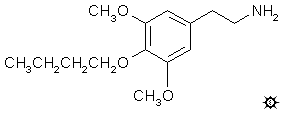
#10 B
BUSCALINE; 4-(n)-BUTOXY-3,5-DIMETHOXYPHENETHYLAMINE
|
| [3D .mol structure] |
A solution of AH was prepared by the cautious addition of 0.67 mL of 100% H2SO4 to 25 mL of 1.0 M LAH in THF, which was being vigorously stirred under He at ice bath temperature. A total of 4.9 g of 4-(n)-butyloxy-3,5-dimethoxyphenylacetonitrile was added as a solid over the course of 10 min. Stirring was continued for another 5 min, then the reaction mixture was brought to reflux on the steam bath for another 45 min. After cooling again to room temperature, IPA was added to destroy the excess hydride (about 5 mL) followed by 10 mL of 15% NaOH which was sufficient to make the aluminum salts loose, white, and filterable. The reaction mixture was filtered, the filter cake washed with IPA, and the mother liquor and washes combined and the solvent removed under vacuum to yield an amber oil. This residue was treated with dilute H2SO4 which generated copious solids. Heating this suspension effected solution, and after cooling, all was washed with 3x50 mL CH2Cl2. The aqueous phase was made basic with aqueous NaOH, and the product extracted with 2x100 mL CH2Cl2. The extracts were evaporated to a residue under vacuum, and this was distilled at 128-138 °C at 0.5 mm/Hg yielding 3.8 g of a colorless oil. This was dissolved in 40 mL IPA, neutralized with concentrated HCl (about 55 drops required) and, with vigorous stirring, 80 mL of anhydrous Et2O was added which produced fine white plates. After standing for several h, the product was filtered, washed with 20% IPA in Et2O, and finally with Et2O. Air drying yielded 3.9 g of 4-(n)-butyloxy-3,5-dimethoxyphenethylamine hydrochloride (B) with a mp of 152-153 °C. An analytical sample melted at 155-157 °C. Anal. (C14H24ClNO3) C,H,N.
DOSAGE: greater than 150 mg.
DURATION: several hours.
QUALITATIVE COMMENTS: (with 120 mg) There is a strange taste, not really bitter, it does not linger. The slight change of baseline has certainly disappeared by the eighth hour. No noticeable changes in either the visual or the auditory area.
(with 150 mg) Throughout the experiment it was my impression that whatever effects were being felt, they were more in body than mind. The body load never mellowed out, as it would have with mescaline, after the first hour or two. Mental effects didn't develop in any interesting way. I was aware of brief heart arrhythmia. Tummy was uncomfortable, off and on, and there was light diarrhea. Even as late as the fifth hour, my feet were cold, and the whole thing left me with a slightly uncomfortable, 'Why did I bother?' feeling.
EXTENSIONS AND COMMENTARY: There is a jingle heard occasionally in chemical circles, concerning the homologues of methyl. It goes, "There's ethyl and propyl, but butyl is futile." And to a large measure this is true with the 4-position homologues of mescaline. This butyl compound, B or Buscaline, had originally been patented in England in 1930 without any physical or pharmacological description, and the few physical studies that had involved it (lipophilic this and serotonin that) suggested that it was less active than mescaline.
In principle, the 5-, the 6-, the 7- and the on-up homologues might be called amylescaline (possibly pentescaline?), hexescaline, heptescaline (possibly septescaline), and God-knows-what-scaline. They would certainly be easily makeable, but there would be little value that could be anticipated from nibbling them. In keeping with the name B (for butoxy), these would be known as A (for amyloxy, as the use of a P could confuse pentoxy with propoxy), as H (for hexyloxy, but careful; this letter has been used occasionally for DMPEA, which is Homopiperonylamine), and as S (the H for heptyloxy has been consumed by the hexyloxy, so let's shift from the Greek hepta to the Latin septum for the number seven). It seems most likely that the toxic symptoms that might well come along with these phenethylamines would discourage the use of the dosage needed to affect the higher centers of the brain. The same generally negative feeling applies to the amphetamine counterparts 3C-B, 3C-A, 3C-H and 3C-S.
A brief reiteration of the 2C-3C nomenclature, to avoid a possible misunderstanding. The drug 2C-B is so named in that it is the two-carbon chain analogue of the three-carbon chain compound DOB. The drug 3C-B is so named because it is the three-carbon chain analogue of the two-carbon chain compound Buscaline, or more simply, B. There is no logical connection whatsoever, either structural or pharmacological, between 2C-B and 3C-B.
| [ |
[Main Index] | [Forward |

